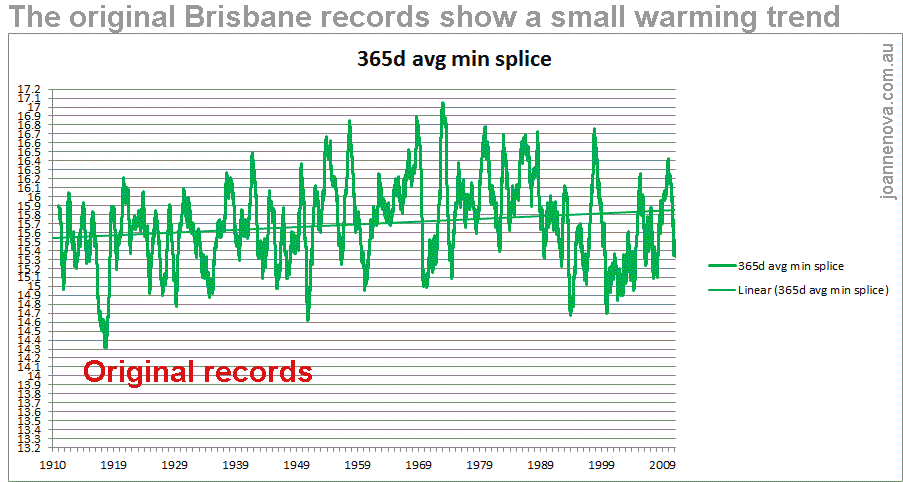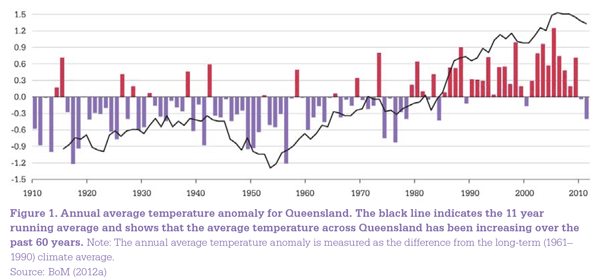Why would we expect truth and accuracy from the Australian Climate Commission?
They are official Warmists but only the credulous would be deceived by them. Their latest puff says:
"Temperatures are expected to continue rising this century. The average temperature for Queensland has risen by about 1°C since early last century, with most of the warming occurring since the 1950s..."
But the rise is almost all "adjustments" to the actual temperature record -- as the blink comparator for S.E. Qld. below shows:

To make it worse, the graph that they themselves provide is completely wacky:

As Jo Nova says: "Eyeballing this graph suggests Queensland’s average temperature has risen by 2.7 C since the 1950′s."
So which is it? A rise of "about" one degree or 2.7 degrees?
With carelessness like that, one is inclined to infer that they are not really serious: Just doing the hack job to deceive the uninformed public that the government pays them to do. If they put up a piece saying that there has been no significant rise in temperatures for the last century, they would soon be out on their ear.
Anybody with normal healthy skepticism would accept government science pronouncements with a large dose of rock-salt and the nonsense above is a good confirmation of the need for that. What does it say about the integrity of the "eminent" people who have put their name to it, however?
Warwick Hughes has a laugh at them too.
Qld. Households to be slugged $240 a year to pay for solar power feed-in tariff
HOUSEHOLDS will soon be slugged $240 annually to pay for the power produced by rooftop solar systems.
New modelling has revealed that by 2015-16, almost 15 per cent of the total household power price will fund the solar feed-in tariff.
The Newman Government has already cut the tariff for home-produced power to 8 per kilowatt hour for all solar systems bought after July 9.
However, the new figures exposing the huge burden being carried by all consumers to pay those who produce solar power may prompt the Government to also reduce the 44/kWh tariff paid to those who previously installed photovoltaic systems.
The Government is investigating ways to reduce network costs - the price of moving electricity from the power generators to people's homes - which account for about 50 per cent of all electricity prices.
The modelling by the Queensland Competition Authority estimates the costs caused by solar for consumers will fall to just under $100 annually, or 6 per cent of power bills, by 2019/20.
Energy Minister Mark McArdle said the Government's decision to cap the scheme had already produced significant savings.
Mr McArdle said the solar feed-in tariff would have cost $1.8 billion by 2028 but this had been reduced by $300 million.
"This cost is passed through to all households in the form of higher network charges, which just adds to the burden of this scheme," he said.
"What we have here is Labor, and its Green partners, hiding its head in the sand and continuing to claim that renewable energy schemes are decreasing the cost of electricity. This is blatantly untrue and the modelling by the QCA should finally end this."
The QCA has been tasked with developing a "fair and reasonable" feed-in tariff by early next year.
However, any move by the Government to retrospectively remove the 44/kWh from households with existing solar systems could be political poison.
About one in every five homes is now fitted with solar panels and the figure is growing daily, with Energex paying out about $10 million a month in August to households with solar panels.
That figure has increased to $13 million in three months.
SOURCE
Job ad decline points to rising unemployment
The number of jobs advertised has fallen for the seventh straight month, hinting at further rises in unemployment ahead.
ANZ's monthly survey shows job ads declined 4.6 per cent in October, following a 3.9 per cent fall in September, and are now down 15 per cent on the levels recorded a year ago.
The level of job ads is now the lowest since January 2010, and ANZ's head of Australian economics Ivan Colhoun says this will translate to further increases in unemployment.
"The general trend of weaker job advertising and continuing job losses as businesses restructure and/or cut costs, suggests continuing upward pressure on the unemployment rate," he noted in the report.
"ANZ forecasts a 5.75 per cent unemployment rate in mid 2013."
The Bureau of Statistics will be releasing official employment data for October on Thursday, and ANZ is forecasting around 8,000 less jobs, but unemployment steady at 5.4 per cent.
Macquarie's senior economist Brian Redican says the longer term trend for jobs is not looking good.
"It's been a deteriorating trend in the job advertisements. We are already seeing unemployment rising to 5.4 percent, and this number shows that the pace of job shedding is actually accelerating, not declining," he told Reuters.
The ANZ report shows newspaper job advertising was particularly weak in Victoria, Western Australia and the ACT, but jumped more than 40 per cent in the Northern Territory, which is typically volatile because of its small size.
SOURCE
Queensland Health's waiting list shows an eight-year delay to see medical specialists
QUEENSLAND Health has published its "waiting list to get on the waiting list", showing some patients are languishing years to see a specialist.
Figures on the department's website for the September quarter show some patients waiting more than eight years to see a specialist before then going on the elective surgery list for an operation.
Across the state, less than a third of the urgent category 1 patients requiring appointments for gastroenterology, rheumatology, neurosurgery, cardiology, pain management and dermatology are seen within the recommended 30 days.
At the Royal Brisbane and Women's Hospital, only 27 per cent of category 1 patients requiring an appointment with a neurosurgeon are successful within the time frame.
The figures show most category 1 patients wait up to 329 days to see a neurosurgeon at the RBWH and may experience further delays if they require an operation.
Queensland's largest hospital has so many category 1 patients needing to see a neurosurgeon, less urgent patients are no longer being seen.
The longest waits at the RBWH are for non-urgent category 3 patients needing to see a plastic and reconstructive surgeon, with 90 per cent waiting up to 3092 days or almost 8 1/2 years.
Category 3 patients are supposed to be seen within 12 months.
But RBWH's executive director, David Alcorn, said the category also included appointments for issues such as "tattoo removals, piercing removals, the removal of excess surface fat and breast reductions".
Waits to see ophthalmologists stretched for years across the state for category 3 patients. Australian Medical Association Queensland president Alex Markwell welcomed the decision to publish the data for the first time, saying it was important to be transparent about how long it took for patients to be seen in the public hospital system.
Queensland Health deputy director-general Michael Cleary defended the figures saying the state's increasing and ageing population was having a significant impact on demand for specialists.
A spokesman for Queensland Health Minister Lawrence Springborg said the Newman Government was determined to be honest about waiting lists.
He said publishing the data put more onus on the newly created 17 hospital and health service boards to fix the problems.
SOURCE
Qld police union wants druggies in the force
REFORMED drug users should be allowed to pursue policing careers, Queensland's police union says.
The union says current rules can prevent former drug users from becoming officers, but not stop them from becoming lawyers or politicians, The Courier-Mail reports.
Talks have been held with the Crime and Misconduct Commission, Queensland Police Service and the union about a review of the standards.
Union president Ian Leavers said the service must acknowledge that some people who experimented with drugs in their youth could still be good police officers.
When asked about the union's push, Queensland's new Police Commissioner Ian Stewart: "We are reviewing our standards in line with community expectations".
Police Minister Jack Dempsey said he would not support any move that would lower recruiting standards.
He says those standards must always reflect community expectations.
Police recruit applicants must declare their drug use, traffic history and other offences when applying to join the service.
Mr Leavers said police recruit applicants were denied entry if they admitted to previous drug use or had significant or recent poor driving history.
"The Law Society, accounting boards, medical registration boards and even MPs take into consideration the circumstances and time of illicit drug use admissions, it makes sense the police service would too," he told the newspaper.
SOURCE
 Australian Politics
Australian Politics


 Evelyn Rae, a conservative Australian political commentator
Evelyn Rae, a conservative Australian political commentator


 Margo Robbie -- a beautiful australian
Margo Robbie -- a beautiful australian
 My son Joe at ANU
My son Joe at ANU
 One of the happiest pictures ever -- Cleo Smith, aged 4
One of the happiest pictures ever -- Cleo Smith, aged 4





No comments:
Post a Comment